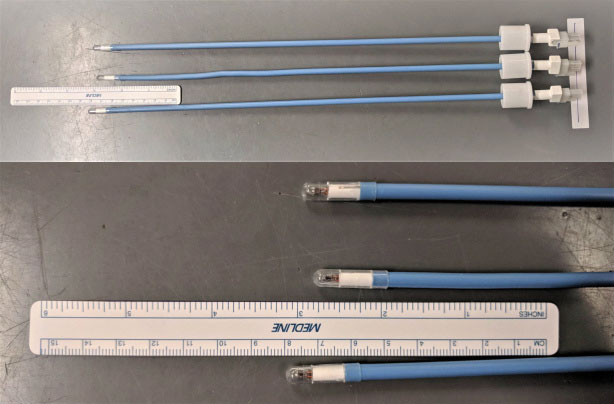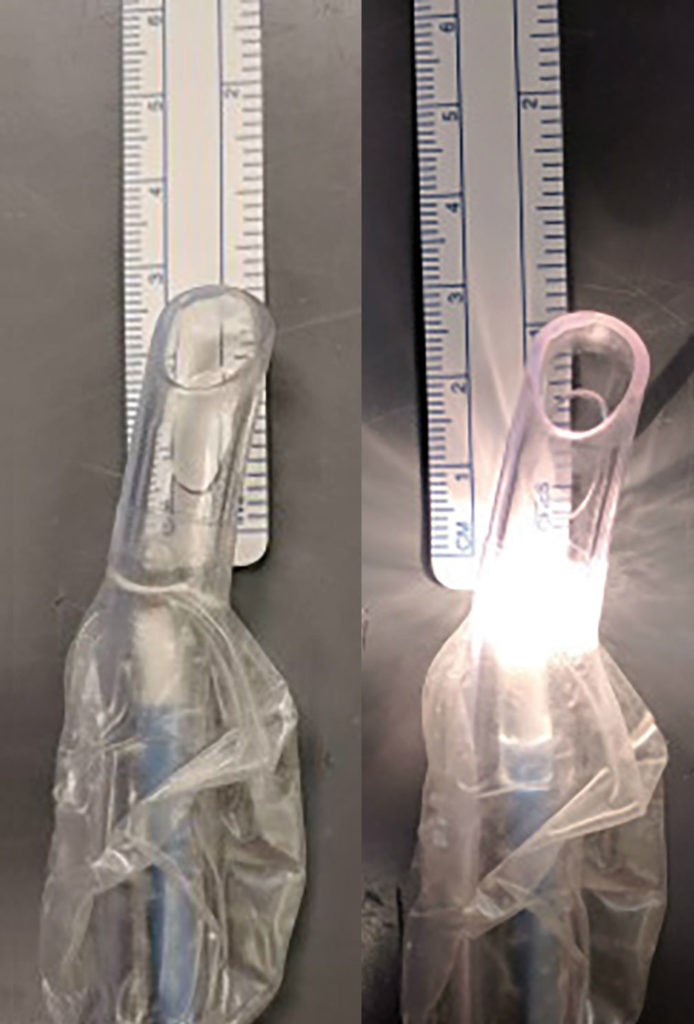Dear Rapid Response:
Lighted stylets are an important component of the ASA Difficult Airway Algorithm.1 Particularly useful in patients with blood or secretions in the airway, lightwands are also helpful in scenarios involving unstable cervical spines and limited mouth openings. During an otherwise routine lightwand-guided endotracheal intubation, we encountered difficulty placing the bulb of the lightwand at the tip of the endotracheal tube (ETT) because the length of the stylet was short. Below, we describe both variation and inadequacy in the length of the available Vital Signs® Orotracheal Lighted Stylets (Vyaire Medical, Mettawa, IL) at our institution.
The product packaging indicates that the stylet can be paired with ETT sizes ranging from 6.0 mm to 10.0 mm without specifying ETT brand.2 However, increasing ETT diameter corresponds with increased ETT length. In our case, a 7.5 mm ETT was used and the tip of the lighted stylet was unable to reach the ETT tip, leading to inadequate transillumination and multiple intubation attempts. We then compared the lengths of different Vital Signs® Orotracheal Lighted Stylets in our inventory and noticed a variation in the length of the stylets (FIgure 1).

Figure 1: Example of three identically packaged Vital Signs® Orotracheal Lighted Stylets (CareFusion). The variation in length approaches one centimeter.
We then compared the lengths of available stylets for use with ETTs 7.5 mm and greater and found that the stylets fell significantly short of the desired length (Figure 2).

Figure 2: Size 8.5 mm endotracheal tube with the Vital Signs® Orotracheal Lighted Stylets (CareFusion) and light turned on and off. The lighted stylet falls approximately 2-3 cm short of the length required for appropriate positioning at the endotracheal tube tip.
Based on these observations, we recommend checking the length of Vital Signs® Orotracheal Lighted Stylets in relation to the desired ETT size to potentially improve first attempt success of intubation, and subsequent patient safety. Given the lengths of available Vital Signs® Orotracheal Lighted Stylets, we found 7.0 mm to be the maximum recommended ETT size that can be used reliably.
Dr. McCormick is a CA-2 resident and Dr. Maheshwari is an assistant professor in the Department of Anesthesiology at the University of Oklahoma Health Sciences Center.
The authors have no conflicts of interest pertaining to this article.
References
- Apfelbaum JL, Hagberg CA, Caplan RA, et al. Practice guidelines for management of the difficult airway: an updated report by the American Society of Anesthesiologists Task Force on management of the difficult airway. Anesthesiology. 2013;118:251–270.
- CareFusion Corporation. Vital Signs orotracheal lighted stylet: an effective tool when intubation proves difficult. January 2018. https://www.vyaire.com/us/our-products/anesthesia-delivery/airway-access-devices/vital-signs-stylets. Accessed March 1, 2019.
Reply:
Product quality is of vital importance to Vyaire, as is customer service. We have taken this observation and communicated to both our quality team and customer service teams for further review. We’d like to let the readers know that an in-depth review of the product design is to occur taking into consideration the information supported by this letter. We thank the APSF and Drs. McCormick and Maheshwari for always thinking of the patient first, as we all do, and alerting us to potential opportunities to improve patient care via our products.
Sincerely,
Steven H. Cataldo, MD
Vice President & Medical Director
Vyaire Medical
Mettawa, IL
The information provided is for safety-related educational purposes only, and does not constitute medical or legal advice. Individual or group responses are only commentary, provided for purposes of education or discussion, and are neither statements of advice nor the opinions of APSF. It is not the intention of APSF to provide specific medical or legal advice or to endorse any specific views or recommendations in response to the inquiries posted. In no event shall APSF be responsible or liable, directly or indirectly, for any damage or loss caused or alleged to be caused by or in connection with the reliance on any such information.


 Issue PDF
Issue PDF